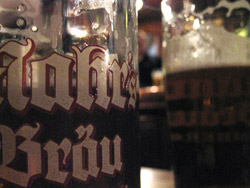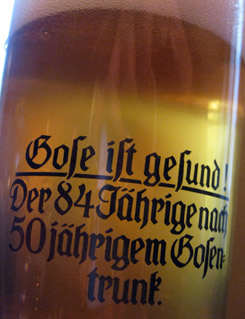Before we begin Phase III of our grand odyssey we’re holed up in snowy New Jersey through the holiday, leaving me a bit of time for Monday musing.
– I paid little attention in October to the final demise of Zima, and just caught up with the excellent piece at Slate about its long and torturous death. A fine lesson about marketing, and an interesting contrast to the rip-roaring success of small-batch beers focusing on flavor and making sure there is a there there.
– We like year-end lists in our house, and not just because I can make fun of the beer-related ones. Books, best recordings, best movies, that stuff. And when Sierra gets it organized we’ll post our Best of the Trip – Europe Edition at The Slow Travelers.
But I’ve given up trying to assemble a “best of beer” for the year, for the European leg, for Germany, for Liechenstein. I can’t even decide on my favorite beer from Cantillon.
 Instead I’ll point you to a list done right. It makes me wish we had managed to collide with Boak and Bailey as all of us bounced around Germany and the Czech Republic. They were in Leipzig when we were in Prague. We were in Dresden when they got to Prague. They blogged about Christmas markets, we went to dozens (Berlin alone has 50).
Instead I’ll point you to a list done right. It makes me wish we had managed to collide with Boak and Bailey as all of us bounced around Germany and the Czech Republic. They were in Leipzig when we were in Prague. We were in Dresden when they got to Prague. They blogged about Christmas markets, we went to dozens (Berlin alone has 50).
It’s not that I agree on all their favorite beers (had six, but part of the point of these lists is to discover new things, right?). Daria and I really didn’t care for the sourness in U Flecku. However we loved the Mahrs Bräu Ungespundet-hefetrüb, and since we were staying one block from the Bamberg tavern and had no ticking agenda were happy to order more.
– Visit Alan and Jeff to see the winners of the 2008 Yule Beer Blog Photos contest. It seems I have a photo in there. Probably a sympathy selection after I whined about getting my butt kicked in previous years. I probably shouldn’t be so flip, because – amazing as it may be – run a contest, give away a lot of nice prizes and somebody is still going to give you grief.
– Interesting to see in “How many cult wines can dance on the head of a pin?” that the number of cult wines has exploded since the mid-1990s. Can you think of a parallel? Here’s a hint.
– And I’ll finish with a press release from home (yes, a bit sad I missed this):
“Blue Corn Brewery (Santa Fe) celebrates old traditions as well as new beginnings with the release of Aztlán Winter Ale on December 13, 2008. The first commercial beer to feature certified organic, native New Mexican hops, Aztlán Winter Ale also incorporates organic malts from the United States and Canada, and clean, pure Northern New Mexican water. This winter warmer has malt overtones of chocolate and plum with hints of orange and spice from the hops.
“Ralph Olson of U.S. hop supplier, HopUnion, reported to a source he knew of no other brewery having used these hops in the past. Blue Corn head brewer Brad Kraus, said, ‘In all my years of research about brewing in New Mexico, I have not found a single reference to the use of Humulus lupulus var. neomexicana, or New Mexican native hops, in the brewing of beer here. Since these were grown organically, I felt it fitting to use only organic ingredients.’
“Todd Bates and business partner Steve Johnson grew the hops just north of Embudo, New Mexico. They have been growing and breeding native New Mexican varieties for four years on their small organic farm.”
I visited Todd and Steve in August of 2007 (mentioned here) and Todd frequently comments here. Hi, Todd.
 I broadcast a link to this
I broadcast a link to this  Instead I’ll point you to a
Instead I’ll point you to a